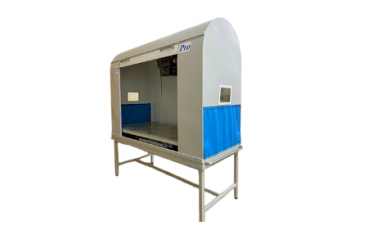Veterinární ochranné prostředky
The Iona3D-Pro cabin set forms the foundation of a new generation of mobile systems for performing high-quality X-ray imaging of animals within veterinary clinics, with minimal doses of residual X-ray radiation and ionized air emissions. This enables a "green" technology that does not produce significant waste or emissions.
The Iona3D-Pro cabin set consists of an X-ray table and a radiation-protective cabin. The cabin fully encloses the area exposed to X-ray radiation during imaging (3D protection – 3D-Pro).
The Iona3D-Pro table is compatible with most X-ray monoblocks weighing up to 20 kg and any flat panel with dimensions of 36x43 cm or 43x43 cm, along with a laptop or personal computer (PC). Typically, compact and relatively lightweight X-ray monoblocks like the Cubex 50 or PXM-20BT, manufactured by JPI and Poskom (both from South Korea), are used. The power of the monoblocks is 5 kW and 1.6 kW, respectively, with weights of 13 kg and 10.2 kg. Other similar X-ray devices may also be used. The recommended X-ray receptor is the Iona-FPD-4343 flat panel, produced by Teleoptic NVK (Kyiv). The Iona-FPD-4343 panel uses Direct Deposit technology to apply the CsI layer to the TFT matrix base, and features a shock-resistant, X-ray-transparent carbon-fiber casing. These characteristics ensure the panel’s durability against impacts and vibrations, as well as maximum sensitivity to X-ray radiation. The use of a sensitive panel combined with efficient image post-processing algorithms further reduces radiation exposure for both the staff and the examined animal.
The Iona3D-Pro table also includes a movable carriage with a vertical bracket for attaching the X-ray monoblock above the table’s deck and a holder for the flat panel underneath the table. The carriage can move freely along the table, ensuring ease of examination for large animals.
The Iona3D-Pro cabin includes a lead-coated tray attached to the table beneath the carriage and a hood mounted on the tray. The hood, like the tray, is lined with lead sheets on the inside, insulated from the air. The middle and upper parts of the hood encompass the vertical bracket with the attached X-ray monoblock above the table’s deck. The equivalent radiation protection of the tray and hood is 0.6 mm lead.
The front wall of the Iona3D-Pro cabin is designed as aluminum shutters with additional 0.5 mm lead protection. These shutters are equipped with a weight compensator for easy lifting with zero effort.
The cabin's left and right side walls have designated spots for personnel to hold the animal on the table during the procedure.
Animal X-ray Imaging Procedure:
Before the X-ray imaging, the person holding the animal sits on a chair in front of the cabin's side wall. They put on radiation-protective gloves and insert their hands into the cabin through the edges of the shutter. With the shutters raised, the operator positions the animal on the table and adjusts it as needed. Then, the operator lowers the shutters. For convenience, autonomous LED lights are used for monitoring the animal’s behavior through windows in the cabin when the shutters are closed. After activating the monoblock generator and completing the X-ray imaging, the operator raises the shutters, retrieves the animal from the holder, and returns it to its owner.
When this procedure is followed on the Iona3D-Pro mobile system, neither clinic staff nor visitors are exposed to unnecessary radiation. Furthermore, calculations and measurements show that no additional radiation shielding for walls, windows, doors, ceilings, or floors is required when using the cabin unit for X-ray imaging.
The Iona3D-Pro cabin-based mobile X-ray systems are economically and logistically ideal for clinics with limited space and few rooms.










